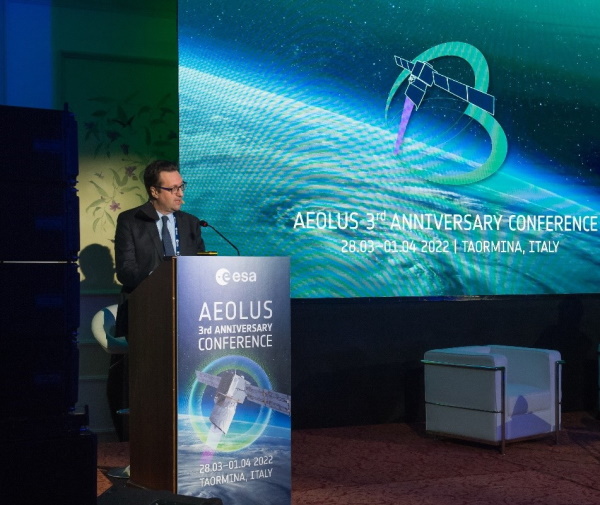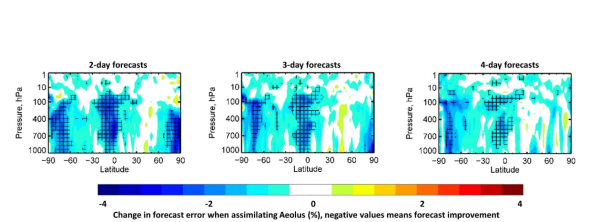- News & Events
- Exploring the prevailing achie...
Exploring the prevailing achievements and future directions of Aeolus
14 Apr 2022
A tight-knit community of European remote sensing experts converged on the Italian island of Sicily last month to discuss how the strong success of ESA’s Aeolus mission is shaping scientists’ understanding of the winds that sweep across the planet.
The Aeolus third anniversary conference took place in the coastal town of Taormina from 28 March to 1 April.
The event took place a short distance from the Aeolian islands, the home of the Greek mythological keeper of the winds after which the mission is named.

Illuminating the winds
After a decades-long development process, Aeolus was lofted into orbit on 22 August 2018, from Europe's spaceport in French Guiana.
Part of ESA’s Earth Explorers programme, the mission set out to help address the need for global wind maps to facilitate improved weather forecasts and advance understanding of the atmosphere.
Aeolus was originally developed as a research and demonstration satellite but, thanks to the high-quality information it delivers, the mission has far outstripped its initial goals.
One of the mission’s biggest achievements is that its data is now used by many meteorological centres across the world to inform enhanced weather predictions.
Aeolus uses one sensor – called the Atmospheric Laser Doppler Instrument (ALADIN) – to deliver global wind profiles.
ALADIN fires short pulses of UV light towards the planet, which bounce off air molecules and other particles as they are blown through the atmosphere. By measuring the shift in frequency of the light that is scattered back to the satellite, Aeolus can determine the speed and direction of the wind in the lowermost 30 km of the atmosphere.

Thriving scientific community
The conference was attended by a thriving community that formed thanks to Aeolus, including the engineers that developed, operate and maintain the mission and the wide variety of scientists that use its high-resolution data.
Several meteorological organisations that use Aeolus data presented at the event, such as the British Met Office, the European Centre for Medium-Range Weather Forecasts, Germany’s meteorological service (DWD) and the US National Oceanic and Atmospheric Administration.
The Met Office, for example, reported that Aeolus data improved nearly all the organisation’s observations, enabling it to deliver more accurate forecasts.
As well as experts in numerical weather prediction, the conference hosted researchers in the fields of atmosphere dynamics and aerosol-cloud interactions, as well as remote sensing scientists that work to calibrate and validate Aeolus data.
Their presentations delved into numerous topics, including monitoring of Saharan dust plumes, improving understanding of polar stratospheric clouds, measuring atmospheric gravitational waves, and synergies with other remote sensing missions.
Open data spark new possibilities
In addition, scientists from around the world are using Aeolus data to test-out many new applications, thanks to the accessibility of the mission’s data.
A new open-access online tool – called the Aeolus Virtual Research Environment (Aeolus VRE) – was showcased at the conference by EOX, the tech firm that led its development.
Aeolus VRE is designed to help scientists realise the huge potential of data delivered by the mission.
It enables users to complete detailed analyses and fosters collaboration between researchers, helping the remote sensing community explore new ways that the mission’s data can boost understanding of the atmosphere.

Paving the way
The conference was also attended by Aeolus mission engineers, who discussed the mission’s achievements as well as its challenges.
Aeolus has exceeded its planned lifespan – but ALADIN continues to deliver global maps of movement in the atmosphere, successfully demonstrating the use of space-borne laser technology to monitor the world’s winds.
The outstanding teamwork between ESA, its industrial partners, and other mission teams that was instrumental in tackling the many challenges encountered during mission development and operation was also highlighted.
This know-how is expected to be crucial for the development of new lidar missions, such as EarthCARE, which will launch in the coming years.

Join us at ESA’s Living Planet Symposium in Bonn
Being held on 23–27 May 2022 in Bonn, Germany, ESA’s prestigious Living Planet Symposium offers attendees the unique opportunity to hear first-hand about the most recent developments in the field of Earth observation. Attendees will be able to hear about the latest scientific findings on our planet and how observing Earth from space supports environmental research and action to combat the climate crisis, learn about novel space technologies and about the new opportunities emerging in the rapidly changing sector of Earth observation. This exciting event not only attracts scientists and academics, but also those working in the space industry, institutional stakeholders, data users, students and citizens – an amazing opportunity to all meet in-person after the Covid pandemic.
More information and registration details can be found at the Living Planet Symposium website.